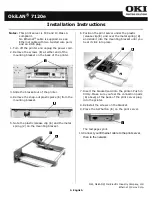
User-defined Characters
You have seen how to design a character by placing dots on a grid
and translating the dots to decimal equivalents. The last step in
defining a character is sending this information to your printer.
Sending Information to Your Printer
The printer loads characters in the print style (Letter Quality, draft,
or proportional) that the printer is currently using. It also records
whether italic, superscript, or subscript is turned on. This means
that if you want to print a character in italics, for example, you must
have the italic mode turned on when you define the character.
The command your printer uses to define characters is one of the
most complex in its repertoire. The format of the command is this:
ESC & 0 n1 n2 d0 d1 d2 data
The ESC & is simple enough. The 0 (which is ASCII code 0, not the
numerical zero in quotation marks) allows for future enhancements.
At this time, it is always ASCII 0.
You can define many characters with a single command. The values
n1 and n2 are the ASCII codes of the first and last characters you are
defining. If you are defining only one character, n1 and
n2
are the
same. You can use any codes between decimal 32 and 127 for n1 and
n2, but it is best not to define decimal 32, which is the code for a
space. Also, you can use letters in quotation marks instead of ASCII
codes for n1 and n2.
Note: Because user-defined characters require additional
memory, you must set DIP switch 2-5 to 1 KB (off) before
downloading these characters.
4-24
Software and Graphics
Содержание ActionPrinter 4000
Страница 1: ......
Страница 2: ...E PSON RP 4 0 0 0 User s Manual ...
Страница 165: ...Chapter 6 Maintenance Cleaning the Printer 6 2 Replacing the Ribbon 6 4 Transporting the Printer 6 10 Maintenance 6 1 ...
Страница 265: ...Appendix Proportional Width Table A 2 Character Tables A 6 A l ...
Страница 285: ...EPSON qmd 4 0 0 0 Quick Reference ...
Страница 289: ...printe edge guides DIP s itch paper tension unit cover power switch ...
















































